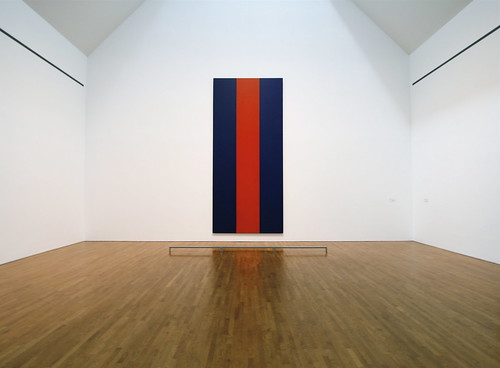
Voice of Fire
Barnett Newman, 1967
As we all know, when the National Gallery of Canada purchased this piece in 1989 for $1.8 million, controversy erupted. How could they spend so much money on a canvas covered with three acrylic stripes?
I have very mixed feelings around both the controversy and the price itself. Indeed, two million dollars for a painting is ridiculous. How much did this piece cost to produce? A few thousand, at most? Let's say, for simplicity's sake, $1800. That's a ten thousand percent mark-up. And for what? Some paint on a stretched piece of cloth?
What we have come to here is a discussion of value. How do we value art? Can we place a commercial value -- a price -- on art, and what we value about it? I believe it is fair to say that in the late 20th century, the art market went a bit haywire. Never before have we seen such inflated prices for artworks, or people purchasing art as an investment. When Japanese businessman Ryoei Saito purchased van Gogh's Portrait of Doctor Gachet for $82.5 million in 1990, did he purchase it for his aesthetic appreciation of it? Did he purchase it to hang in his home or business, for people to appreciate and enjoy? Or did he purchase it as collateral -- to get himself out of financial troubles when he lost his money a few years later with the Japanese bubble burst? (No one knows where the painting is now. He sold it to an anonymous buyer when he went bust.)
Trying to assign monetary value in a post-capitalist society to works of art, often made before this period, is trouble waiting to happen. Did van Gogh expect his Irises painting to fetch over a hundred million dollars sometime in the next century? Of course not. But a more interesting question is whether he would approve. If you spoke to any artist in the late 19th century, what would their reaction be? I choose this period because it one that exists after the invention of the museum (yes, the invention) and after the 'art world' began to take off, yet before the hyper-inflation and use of art as a commodity. My bet is that van Gogh would be horrified.
So what is an artist to do in such a climate? You could join it and make 'commercially viable' pieces to sell; make a living out of selling your pieces, hoping to make it into the upper echelons of the likes of Satchi. Or you could rebel, and make pieces that are impossible to sell. How do you sell a performance? How do you sell an installation piece that will be destroyed once the show is over? What about a plot of land? A hill? A building covered with fabric?
Has Modernism Failed? is an intriguing book by Suzi Gablik, written in 1984, a time when the art world seemed lost and directionless, with no guiding moral authority and no bloody point. Beauty was no longer a concern -- abstraction had erased that point. But we could go no further with abstraction. How do you go further than an monochrome canvas? Even moving off a canvas entirely was done. A single action could be declared art. And if everything is art, then nothing is. But if everything is art, then why do some pieces fetch millions, while others are left to the wayside? How can anyone own a piece of art, if art can be a naked woman reading poetry out loud while covered in chocolate? How can you own what is un-ownable?
I think what my wandering thoughts have lead to is a recognition that the hyper-inflation of the art market is simply ludicrous. Then again, we all know this. This discussion has lead nowhere. Without boundaries laid out between what is art and what is not, and what art is valuable and which isn't, we are lost. John Carey has something going on when he asks:
No comments:
Post a Comment